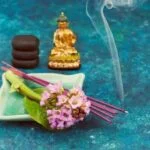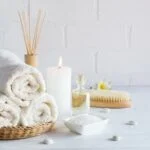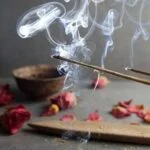Art for aromatherapy oils offers a unique and innovative approach to holistic well-being, combining the benefits of both art and aromatherapy for a truly transformative experience. By integrating art into your aromatherapy practice, you can tap into the healing power of creative expression while reaping the therapeutic benefits of essential oils. This article delves into the concept of using art in conjunction with aromatherapy oils, highlighting how these two practices can synergistically enhance mental, physical, and emotional health.
Aromatherapy oils have long been recognized for their potent healing properties, aiding in relaxation, stress relief, improved sleep, and more. The use of essential oils in combination with art takes this healing potential to new heights by engaging multiple senses and stimulating creativity. Through the sensory experience of both visual art and aromatic scents, individuals can achieve a deeper level of relaxation and emotional balance, promoting overall well-being.
The artistic connection in aromatherapy goes beyond just aesthetics – it serves as a means of self-expression and introspection. Artistic expression has been linked to improved mental health outcomes, such as reduced anxiety and increased self-awareness.
When combined with the therapeutic effects of aromatherapy oils, individuals can unlock a powerful tool for self-care and personal growth. In the following sections, we will explore how you can harness the synergy between art and aromatherapy to enhance your own well-being journey.
The Healing Power of Aromatherapy Oils
Aromatherapy oils have long been utilized for their therapeutic benefits on both mental and physical health. These essential oils, extracted from plants and botanical sources, contain various properties that can promote relaxation, uplift mood, and alleviate symptoms of stress and anxiety. The use of aromatherapy oils has been linked to improved sleep quality, reduced inflammation, and enhanced overall well-being. Incorporating these oils into your daily routine can have a profound impact on your health.
Mental Health Benefits
One of the primary advantages of using aromatherapy oils is their positive impact on mental health. Certain oils like lavender, chamomile, and citrus scents have been known to reduce symptoms of anxiety and depression.
The inhalation of these fragrances can trigger the release of neurotransmitters like serotonin and dopamine, which are responsible for regulating mood and emotions. Aromatherapy oils are also effective in promoting relaxation and stress relief, making them a popular choice for individuals looking to unwind after a long day.
Physical Health Benefits
In addition to their mental health benefits, aromatherapy oils also offer several advantages for physical well-being. Oils like eucalyptus, peppermint, and tea tree have anti-inflammatory properties that can help relieve muscle pain, headaches, and respiratory issues. When used topically or inhaled through diffusion, these oils can provide relief from common ailments like congestion, sore muscles, and digestive discomfort.
Furthermore, certain essential oils are antibacterial or antiviral in nature, helping to boost the immune system and ward off illnesses. By incorporating these oils into your daily routine, you can support your physical health while enjoying their pleasant scents as well.
The Artistic Connection
Art has the power to evoke emotions, memories, and creativity – all of which can enhance the therapeutic effects of aromatherapy oils. By incorporating art into aromatherapy practices, individuals can personalize their healing journey, creating a harmonious environment conducive to relaxation and emotional release. Whether through painting, drawing, or sculpting, expressing oneself artistically while enjoying the aromatic scents of essential oils can provide a multi-sensory experience that promotes deep relaxation and inner peace.
Studies have shown that engaging in creative activities such as art-making can reduce cortisol levels (the stress hormone) in the body, lower blood pressure, and improve overall mood. Combining these benefits with the calming and grounding effects of aromatherapy oils creates a powerful synergy that supports emotional balance and mental clarity. By exploring the artistic connection in conjunction with aromatherapy oils, individuals can tap into their innate creativity while reaping the therapeutic benefits for a truly enriching holistic experience.
| Benefit | Effect |
|---|---|
| Reduced Stress | Art for aromatherapy oils helps reduce cortisol levels |
| Emotional Release | The combination promotes relaxation and emotional expression |
| Mood Improvement | Creative activities paired with essential oils lead to better mood |
Creating Your Own Art
Creating art to complement your aromatherapy practice can be a deeply fulfilling and therapeutic experience. Art has the power to evoke emotions, stimulate creativity, and provide a sense of relaxation, making it a perfect addition to your holistic well-being routine. When combined with the healing properties of aromatherapy oils, art can create a harmonious environment that nurtures both the mind and body.
One way to incorporate art into your aromatherapy practice is by creating custom artwork that reflects the scents and therapeutic benefits of your favorite essential oils. For example, if you enjoy using lavender oil for its calming effects, you could paint or draw scenes inspired by lavender fields to enhance the relaxing ambiance of your space.
Similarly, if you prefer energizing scents like peppermint or citrus oils, you could create vibrant and uplifting artwork to complement the invigorating properties of these oils.
Experimenting with different artistic mediums such as painting, sketching, collage, or even sculpture can add variety and depth to your art for aromatherapy oils practice. Don’t be afraid to mix and match techniques or try something new – the goal is to express yourself creatively while enhancing the therapeutic benefits of your aromatherapy routine. Remember that there are no rules when it comes to creating art for aromatherapy oils; let your imagination guide you and allow yourself to explore freely.
| Benefits of Art for Aromatherapy Oils | Enhancing Your Aromatherapy Practice With Art |
|---|---|
| Stimulates creativity | Customize artwork inspired by specific essential oils |
| Evoke emotions | Experiment with different artistic mediums |
| Promotes relaxation | Encourages self-expression and exploration |
Using Art in Aromatherapy
When incorporating art into your aromatherapy routine, there are various practical ways to enhance the therapeutic benefits of both practices. Here are some ideas to help you seamlessly integrate art and aromatherapy oils for a more holistic approach to well-being:
- Custom Art for Your Diffuser: Consider creating or purchasing customized labels for your essential oil bottles or diffusers. This personal touch can add a special element to your aromatherapy experience.
- Aromatherapy Journaling: Combine the power of art and writing by keeping an aromatherapy journal. Use colors, drawings, or sketches to document your feelings before and after each aromatherapy session.
- Artistic Affirmation Cards: Design small affirmation cards with uplifting messages or quotes that resonate with you. Place these cards near your favorite essential oils to create a positive atmosphere during your self-care routine.
Additionally, you can explore incorporating mandalas, watercolor paintings, or even sculptures into your aromatherapy space to create a soothing environment that promotes relaxation and mindfulness. Experiment with different art forms that speak to you personally and allow yourself to express your creativity through the combination of art for aromatherapy oils.
Remember that art is subjective and unique; there is no right or wrong way to incorporate it into your aromatherapy practice. Find what resonates with you and brings you joy, peace, and healing as you delve deeper into the world of holistic well-being through the fusion of art and aromatherapy oils.
The Psychology of Color
Art and aromatherapy oils have long been used individually for their therapeutic benefits, but when combined, they create a powerful tool for achieving holistic well-being. One fascinating aspect of this combination is the psychology of color and how different colors in art and oils can impact emotions and mood. Understanding this connection can help individuals tailor their art and aromatherapy practice to better address their specific needs.
The Power of Color in Art
Colors have the ability to evoke a wide range of emotions and influence our mood. For example, warm colors like red, orange, and yellow are often associated with energy, warmth, and passion. These hues can be particularly invigorating when used in art pieces meant to stimulate creativity or motivation.
On the other hand, cool colors such as blue, green, and purple are known for their calming effects. Incorporating these shades into artwork intended for relaxation or stress relief can enhance the soothing properties of aromatherapy oils.
Color Correspondence in Aromatherapy Oils
Just as each color carries its own psychological implications, different essential oils used in aromatherapy can also be associated with certain emotions or benefits. For instance, lavender essential oil is often linked to relaxation and tranquility, while citrus oils like lemon or orange are commonly used for an uplifting effect.
By matching the colors in your art with corresponding aromatherapy oils based on their therapeutic properties, you can create a harmonious blend that enhances both visual appeal and emotional well-being. Experimenting with color combinations that resonate with you personally can further amplify the healing effects of art for aromatherapy oils.
Artistic Aromatherapy DIY Projects
Art for aromatherapy oils is a dynamic combination that can amplify the benefits of both practices. By infusing art into aromatherapy products, individuals can create personalized and unique blends that cater to their specific needs and preferences. One way to incorporate art into aromatherapy is by creating DIY projects that not only look visually appealing but also enhance the therapeutic properties of the oils used.
An easy and creative DIY project to try is making your own art-inspired essential oil diffuser jewelry. This could be in the form of necklaces, bracelets, or even keychains. By adding a few drops of your favorite essential oil to these pieces, you can enjoy the benefits of aromatherapy throughout the day. Choose colors and designs that resonate with you personally, as this will further enhance the positive effects of both the art and oils.
Another fun project to explore is creating custom-designed labels for your aromatherapy blends. Whether you are making rollerball blends, room sprays, or candles, designing your own labels adds a personal touch to your creations. Use different colors, patterns, and images that reflect the mood and purpose of each blend.
Not only will this make your products visually appealing, but it will also make them more enjoyable to use. Embracing art in these small details can elevate your aromatherapy experience to a new level of sensory delight.
Case Studies
Art for aromatherapy oils has been proven to be a powerful tool in helping individuals find relief from various physical and mental health issues. Let’s look at some real-life examples of how combining art with aromatherapy oils has positively impacted the healing journey of individuals:
- Sarah, a cancer survivor, found solace in painting mandalas while inhaling lavender essential oil during her chemotherapy sessions. The combination of creating intricate art patterns and the calming scent of lavender helped her cope with the side effects of treatment and reduce anxiety levels.
- John, who struggled with chronic insomnia, started incorporating diffusing sleep-inducing essential oils like chamomile and bergamot while practicing relaxation painting techniques before bedtime. The soothing aroma coupled with the act of painting helped him unwind, promoting better sleep quality and overall well-being.
- Maria, dealing with stress and burnout from work, began using uplifting citrus essential oils like lemon and orange while engaging in expressive art therapy sessions. The vibrant colors she painted with mirrored the energy-boosting properties of the citrus scents, leading to a significant improvement in her mood and productivity levels.
By sharing these inspiring case studies, we can see firsthand how art for aromatherapy oils can play a vital role in enhancing the healing process for individuals facing various health challenges. It showcases the undeniable connection between creativity, fragrance, and emotional well-being, highlighting the transformative impact this holistic approach can have on one’s overall quality of life.
Conclusion
In conclusion, the combination of art and aromatherapy oils offers a unique and powerful approach to holistic well-being. By harnessing the healing properties of essential oils and the expressive nature of art, individuals can experience profound benefits for their mental and physical health. The therapeutic effects of aromatherapy oils are enhanced through the creative process of making art, allowing individuals to engage in self-expression and self-care simultaneously.
Exploring the synergistic relationship between art and aromatherapy oils opens up a world of possibilities for personal growth and healing. Whether through painting, drawing, or crafting, creating art that complements your aromatherapy practice can deepen your connection to the oils and amplify their therapeutic effects. The colors used in your artwork can also play a significant role in influencing emotions and moods, further enhancing the overall experience of using art for aromatherapy oils.
As shown in real-life case studies, individuals have experienced transformational benefits by incorporating art into their aromatherapy routines. From reducing stress and anxiety to promoting relaxation and emotional balance, the power of art for aromatherapy oils is undeniable. As you explore this innovative approach to well-being, remember to embrace creativity, express yourself authentically, and enjoy the journey of discovering the profound impact that art can have on your overall health and wellness.
Frequently Asked Questions
How Do You Use Artnaturals Essential Oils?
I use Artnaturals essential oils primarily for aromatherapy purposes. I diffuse them in an oil diffuser to create a calming atmosphere at home or add a few drops to my bath for a relaxing experience. Sometimes, I also mix them with carrier oils for massage.
Is Aromatherapy a Science or Art?
Aromatherapy can be seen as a combination of both science and art. The science aspect involves the chemical properties of essential oils and how they affect the body, while the artistic side involves blending scents to create specific moods or emotions. It is a holistic approach that combines both elements.
Can I Mix Essential Oils With Paint?
While it is possible to mix essential oils with paint, it is crucial to do so carefully and with proper knowledge. Some essential oils might not mix well with certain types of paints or mediums, so it’s important to research and test before incorporating them into your artwork.
Additionally, consider the potential impact on the final appearance and longevity of your painting before proceeding with mixing essential oils and paint.

Are you looking for a natural way to improve your health and wellbeing?
If so, aromatherapy may be the answer for you.





